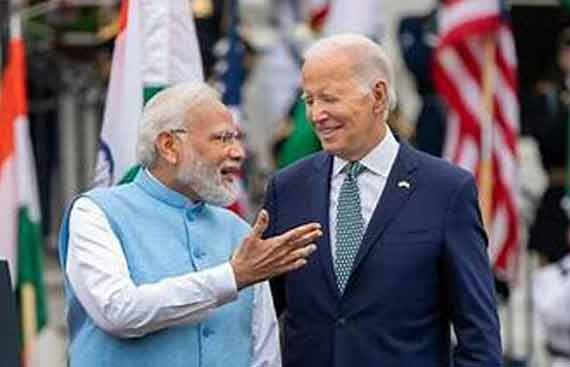The US-India Partnership Redefines Global Cooperation

The US-India Great Power Partnership aims to modernize global affairs, modernize institutions, and ensure fair representation. The US focuses on economic security and institutional solidarity.
The partnership between the United States and India stands out for its unprecedented scope. It promises substantial advancements in both nations' security interests and shapes a global landscape advantageous to them both. The coordination and collaboration between the world's longest-standing democracy and its largest democracy hold significant implications regionally and globally. This strategic alignment necessitates sustained foresight, concerted action, and adherence to a new realist paradigm and lexicon
Prioritizing pragmatic and principled interests and values is essential for formulating a novel strategic framework and vocabulary for the US-India partnership that is free from past preconceptions. Indeed, both countries have aptly termed this relationship "the most consequential of the twenty-first century." Leaders from both nations have also called it a "comprehensive strategic partnership," a label shared with the United States' partnerships with Vietnam and Indonesia. However, India's unique position merits a distinctive classification: a Great Power Partnership.
Areas of Collaboration
Both nations find themselves amid significant electoral cycles, with India's six-week national vote and the United States preparing for elections later this fall. However, the bonds between these countries transcend any single administration, underlining the enduring nature of their relationship, notwithstanding the pivotal role of successive Indian administrations.
Yet, establishing this new paradigm in the Great Power Partnership demands more than mere rhetoric. Both nations must propel advancements across four key domains:
Defense Co-production: It is mutually beneficial for both nations to bolster India's position as the premier naval force and logistical hub in the Indian Ocean and establish itself as a key munitions manufacturer in the free and open Indo-Pacific region. Collaboration between the US and India should extend beyond co-producing jet engines and armored vehicles to encompass autonomous weaponry, solidifying their roles as pivotal players in the democratic defense industrial chain.
Space Collaboration, Development, and Exploration: India presents the United States with an ambitious and proficient partner in space endeavors. It offers technical expertise coupled with a cost-effective approach. Close cooperation with American public and private entities stands to significantly enhance India's space program, leveraging its scale and affordability to magnify US space investments and extend benefits to the Global South.
Development and Governance of the Digital Economy Driven by Artificial Intelligence (AI): Both nations, as leading digital startup nations, share a common perspective rooted in innovation regarding digital governance. While Europe tends to adopt a regulator's viewpoint, the United States and India are positioned to shape international AI digital governance that fosters responsible innovation and application, aligning with their mutual interests.
Winning Hearts and Minds of the Global South: India advocates for enhanced representation within the existing international order to reflect demographic and economic realities. The US-India partnership elevates India's standing among Global South nations and facilitates US engagement with the region. Both countries are vested in garnering support for the rules-based international order, with India poised to lead this endeavor.
Deepening the partnership
As democratic nations, the United States and India share a common interest in strengthening and modernizing the rules-based institutions that govern global affairs. In the twenty-first century, they have the potential to shape a new international order akin to the influential role played by the United States and Europe in the twentieth century. Given their status as the most significant American and Asian countries, they ensure that the twenty-first century's international order fairly represents regions such as the Med-Atlantic, the Indo-Pacific, and the Global South, reinforcing their shared values of liberty and dignity for all.
Cultural affinity and institutional solidarity reinforce the partnership between the United States and Europe, as evidenced by their shared membership in key organizations such as NATO, the Group of Seven (G7), and the Organisation for Economic Co-operation and Development (OECD). However, while the influence of the Indian diaspora in US society is on the rise, the US-India partnership currently lacks comparable levels of cultural affinity and institutional solidarity. Both nations must work towards developing these aspects over time.
With India projected to become the world’s third-largest economy by the end of the decade, the United States should take the lead in inviting India to join prestigious organizations such as the G7 and the OECD. Prioritizing economic security, both nations should focus on integrating Indo-Pacific nations into their collective economies through binding agreements.
The United States and India have made significant progress in coordinating through various multilateral institutional arrangements, including the Initiative on Critical and Emerging Technology, the 2+2 Ministerial Dialogue, and the Quadrilateral Security Dialogue (Quad). The frequency and scope of joint military exercises and intelligence sharing are increasing. However, US-India strategic dialogues on defense and economic coordination need to expand and deepen to regularly engage officials from both administrative structures, facilitating greater interoperability and knowledge sharing.
Enhancing institutional solidarity and people-to-people connections should also be a priority for the United States and India. Strengthening engagement between Middle America and Middle India is crucial. With the United States revitalizing domestic manufacturing across digital and industrial sectors and facing a shortage of skilled technicians, and India possessing a pool of technically competent graduates seeking better employment opportunities, a US-India science and technology mobility agreement could foster greater knowledge sharing and co-development between the two digital economies.
While the US-India Great Power Partnership is poised for success, it requires a nuanced understanding of the cultural, demographic, and political dynamics at play in both countries. Addressing entrenched skepticism and mistrust in bureaucratic circles and media outlets is essential. The business communities of both nations set an example through their cooperative and understanding approach. Overcoming historical hesitations, a constructive Great Power Partnership between the United States and India can advance their core interests and values in the future.
